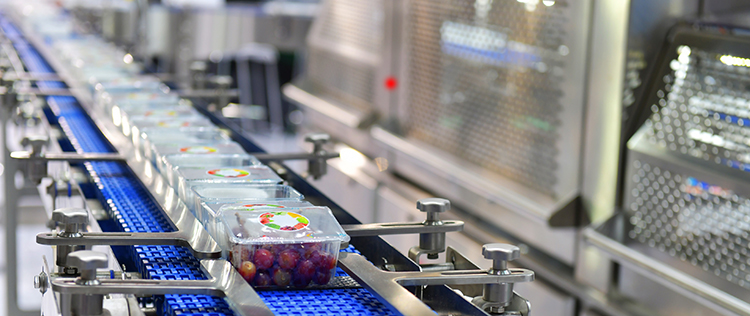An Economical Approach To Acute Packaging Issues
- Like
- Digg
- Del
- Tumblr
- VKontakte
- Buffer
- Love This
- Odnoklassniki
- Meneame
- Blogger
- Amazon
- Yahoo Mail
- Gmail
- AOL
- Newsvine
- HackerNews
- Evernote
- MySpace
- Mail.ru
- Viadeo
- Line
- Comments
- Yummly
- SMS
- Viber
- Telegram
- Subscribe
- Skype
- Facebook Messenger
- Kakao
- LiveJournal
- Yammer
- Edgar
- Fintel
- Mix
- Instapaper
- Copy Link
Posted: 4 February 2021 | OSIsoft | No comments yet
In the race to stay competitive, food producers are constantly working to adapt to changing market conditions.


Food products boxs transfer on Automated conveyor systems industrial automation for package
An Economical Approach To Acute Packaging Issues
In the race to stay competitive, food producers are constantly working to adapt to changing market conditions. Those challenges are now even more pronounced — with the coronavirus pandemic driving a major shift in consumer habits from restaurant dining to home meals — and the rapid change is causing significant stress on packaging equipment lines
While packaging issues need to be addressed specifically, now more than ever, it doesn’t make sense to implement a single, isolated tool.
The most cost-effective approach to packaging is one that is integrated into an advanced data infrastructure as part of a wider solution to improve quality, safety, sustainability, and asset health. To understand more about the technology, Food Online spoke with Ted Combs, Industry Principal-Food & Beverage for OSIsoft, LLC.
To put things into perspective, give me an example of how the shift to home consumption is impacting packaging.
Let’s say you have a large vat of a condiment, such as mayonnaise, that was being sent to restaurant chain. The demand for that product hasn’t gone away, but now the same amount of the product is going into small plastic jars for home use. A plant that might have produced a few hundred thousand units of consumer packaging in a week may now be asked to produce millions of units. That’s where the stress becomes acute. Packaging equipment is complex — fraught with small components that are susceptible to breaking — and they can bring the whole production line to a grinding halt.
What’s the deeper issue?
In the packaging equipment, there are many direct-drive and servo motors in constant motion, so wear is inevitable. These motors are often generic and replaceable, but mechanical problems still cause downtime and delays. Often the controls are not integrated, as there are HMIs [human-machine interfaces] connected to PLCs [programmable logic controllers] at each operational station, so a person on the floor is controlling the process. It’s not someone in a centralized control room. Most of the valuable data is in a form that could be captured, but even if it is captured in some operational historian, it isn’t readily available or contextualized.
Where does an advanced data infrastructure come into the picture?
By putting all the data in context, it allows equipment maintenance to be shifted from traditional break-fix and calendar-based methodologies to conditional and predictive systems based on the actual health of the asset. The practice avoids both the performance of unnecessary work as well as the pitfall of putting off something that is truly needed. Improved maintenance systems reduce the possibility of unplanned downtime at the plant.
Preventing the failure and downtime of key assets such as packaging equipment by increasing their lifecycles is a major function of process optimization systems, which constantly assess the current health of equipment and make the comparison to historical performance.
What makes OSIsoft’s PI System so applicable to food production applications?
The PI System is an advanced data infrastructure that is a purpose-built platform for data contextualization, which allows food manufacturers to take full advantage of the sensors and other smart devices throughout their facilities. The PI System can be implemented over existing data systems, including many legacy programs, and used to extract and interpret the data from all of them. This means one solution can address packaging as part of a bigger, overarching improvement tool. There is no need to acquire any other software tools.
How does this approach to intelligence provide multiple advantages?
It allows management at all levels to make data-driven decisions. The operational personnel have information from outside their unit, so they can see how the system is running upstream and downstream in their process. The data infrastructure also enables connectivity to partner companies — so that downstream consumers can see inventory levels and quality reports. It’s not just who can use data, it’s how the data can be used. In addition to asset health, it can be used to significantly impact operational efficiency; food quality/safety tracking — both within the company and outside of it; maintenance; and sustainability and environmental impact.
So, the reason for an advanced data infrastructure is that there is no application that can do all of this. Is that correct?
Yes. The data infrastructure approach allows for integration of all the data sources — the islands of automation, the information that is not yet part of a control system or network — like vehicles and more. The data infrastructure allows the development of custom applications for the line operators, for engineers working on operational efficiency, maintenance, and sustainability, for local management, and senior management. And all the data is delivered in real time.
What’s an example of the PI System helping to solve a real-world packaging problem?
For global food producer Kellogg, its Valls plant in Spain was rated at 68 percent for overall equipment effectiveness, but the company wanted to reach 80 percent — the benchmark for the industry’s best-in-class rating.
The plant’s management needed to increase the equipment mean time between failures rate and reduce the number of minor stops on the line to meet its for overall equipment effectiveness goal. Better root cause analysis could isolate bottlenecks and reduce stops and line efficiencies. To accomplish that, the plant used asset framework to essentially create digital twins of all equipment on the packing line. The asset framework in the PI System brought machine metrics onto dashboards, which allow operators to control packing-line efficiency in real time and spot maintenance alerts before problems arise. By 2018, the Valls plant reached the 80 percent for overall equipment effectiveness benchmark and extended its average mean time between failures rate by 180 percent, from 10 minutes to 28 minutes.









